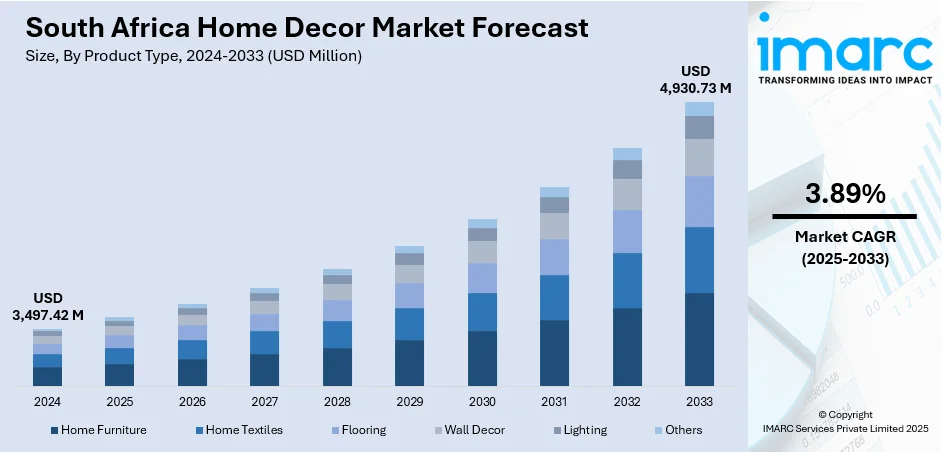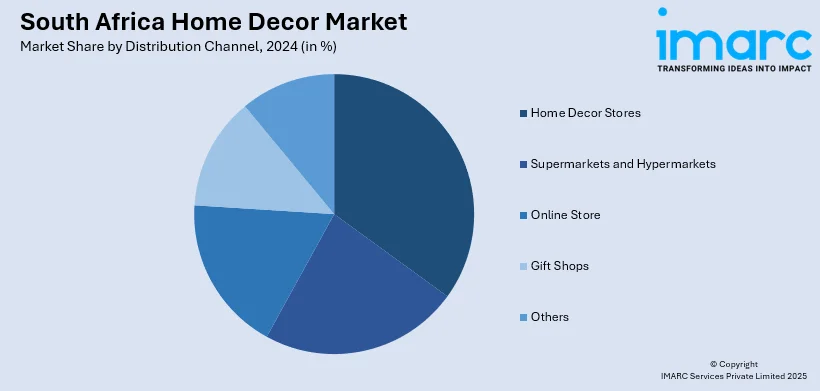
South Africa Home Decor Market Size, Share, Trends and Forecast by Product Type, Distribution Channel, and Region, 2025-2033
South Africa Home Decor Market Overview:
The South Africa home decor market size reached USD 3,497.42 Million in 2024. The market is projected to reach USD 4,930.73 Million by 2033, exhibiting a growth rate (CAGR) of 3.89% during 2025-2033. The market is growing due to rising urban housing projects, increased middle-class income, and growing interest in premium and eco-conscious designs. Digital retail channels are enhancing accessibility, while the South Africa home decor market share grows through the fusion of modern trends with traditional African aesthetics.
|
Report Attribute
|
Key Statistics
|
|---|---|
|
Base Year
|
2024
|
|
Forecast Years
|
2025-2033
|
|
Historical Years
|
2019-2024
|
| Market Size in 2024 | USD 3,497.42 Million |
| Market Forecast in 2033 | USD 4,930.73 Million |
| Market Growth Rate 2025-2033 | 3.89% |
South Africa Home Decor Market Trends:
Increasing Middle Class Population
The South African middle class is continuously growing, and this population change is driving demand for home decor items. Consumers are looking to increasingly personalize their homes, demonstrating a mounting aspiration for comfort and style. With rising incomes, there is a boost in discretionary spending, with home decor being a prominent area for investment. Individuals are now placing more emphasis on the look of their homes, driven by global style and domestic tastes. This growing middle class is also becoming more interested in trying out different home furniture styles, ranging from simple to intricately designed traditional types. Both value and premium home decor products are experiencing increasing demand, prompting brands and retailers to service a wide range of customers, from price-sensitive to high-end consumers. The Majority Report 2025, released by the University of Cape Town’ The Liberty Institute (UCT) disclosed that South Africa's labor force – families with income ranging from R8 000 to R22 000 each month – has grown considerably in spite of the nation's persistent financial difficulties.

To get more information on this market, Request Sample
Technological Advancements and E-commerce Growth
South African shoppers are adopting e-commerce for home decor purchases, driven by technology advancements. Digital sites are making it convenient for consumers to shop and buy home decor products from the comfort of their homes. Retailers are putting a lot of investment into easy-to-use websites and mobile apps, making shopping more enjoyable. Social media sites are also contributing to home decor trends, as customers are constantly exposed to fresh designs, inspiration, and influencers. Virtual and augmented reality (AR) platforms are also being incorporated into websites, enabling customers to see how products will appear in the home before they buy, further fueling the move online in the South African home decor market. IMARC Group predicts that the South Africa e-commerce market is projected to attain USD 2,199.27 Billion by 2033.
Enhanced Awareness of Eco-Friendly and Sustainable Products
South African consumers are increasingly aware about the green footprint of their shopping habits, which has created a growing demand for eco-friendly and sustainable home decor items. People are now going out of their way to look for products made of recycled, organic, or sustainably produced materials. This is being led by increased environment consciousness, not only on a worldwide level but in South Africa too, coupled with that of green-conscious influencers and companies. Store owners and designers are addressing this by providing sustainable alternatives, including furniture from reused wood, cotton fabrics made from organic materials, and energy-saving lighting. Consumers are also turning to brands that engage in ethical production and patronize local artisans, contributing to the demand for sustainable home decor in South Africa. Various local sellers and manufacturers are participating in exhibitions to showcase unique homedecor products. In 2024, the 100% Design Africa took place where artisans showed product design, furniture, decor, lighting and art.
South Africa Home Decor Market Growth Drivers:
Local Design Trends and Cultural Influences
South African home decor is shaped significantly by local culture, heritage, and deep history of craftsmanship. The market is seeing an emerging trend towards integrating indigenous art and design features into contemporary interiors. Consumers are now placing more value on original, locally made products, which has seen a boom in the demand for handmade furniture, textiles, and decorative items that reflect the rich diversity of South Africa's cultures. This demand for indigenous designs and local craftsmanship is being stimulated by the growing success of local artisans and designers who are becoming more popular for producing pieces that marry traditional and modern styles. The increased respect for African design and art is prompting customers to seek out home furnishings that present their own personal cultural heritage while contributing to the local economies.
Urban Developments and Evolving Living Spaces
With urban developments increasing in South Africa, many are settling into smaller living areas, especially in cities such as Johannesburg, Cape Town, and Durban. This is driving the home decor industry, with consumers seeking furniture and decorative solutions that maximize space without sacrificing style. Modular, multi-functional pieces of furniture are gaining popularity since they can be easily customized and space used to the maximum. Consumers are also embracing minimalist design ideologies to create the illusion of more space in their homes. The need for compact space solutions, along with the desire for fashionable yet functional home decor, is assisting in propelling innovation in the market in South Africa. The change is also contributing towards an increase in demand for decor capturing urban lifestyles and modern design sensibilities.
Increase in Home Makeovers and Awareness of Interior Design
South African homeowners are increasingly spending money on home remodeling and interior decorating, seeking to both enhance the functionality and beauty of their living areas. More and more individuals are employing professional interior designers or looking at web sites for ideas and advice. TV programs, social media personalities, and blogs are promoting awareness of the significance of quality design in the home. The increase in DIY home decoration projects is also fueling the market, with consumers demanding tools, materials, and products that enable them to customize and enhance their areas. This increased desire for home remodeling is not only pushing for the demand for home decor but also for well-designed furniture, lighting, and decor.
South Africa Home Decor Market Segmentation:
IMARC Group provides an analysis of the key trends in each segment of the market, along with forecasts at the regional/country levels for 2025-2033. Our report has categorized the market based on product type and distribution channel.
Product Type Insights:
- Home Furniture
- Home Textiles
- Flooring
- Wall Decor
- Lighting
- Others
The report has provided a detailed breakup and analysis of the market based on the product type. This includes home furniture, home textiles, flooring, wall decor, lighting, and others.
Distribution Channel Insights:

- Home Decor Stores
- Supermarkets and Hypermarkets
- Online Stores
- Gift Shops
- Others
A detailed breakup and analysis of the market based on the distribution channel have also been provided in the report. This includes home decor stores, supermarkets and hypermarkets, online stores, gift shops, and others.
Regional Insights:
- Gauteng
- KwaZulu-Natal
- Western Cape
- Mpumalanga
- Eastern Cape
- Others
The report has also provided a comprehensive analysis of all the major provinces, which include Gauteng, KwaZulu-Natal, Western Cape, Mpumalanga, Eastern Cape, and others.
Competitive Landscape:
The market research report has also provided a comprehensive analysis of the competitive landscape. Competitive analysis such as market structure, key player positioning, top winning strategies, competitive dashboard, and company evaluation quadrant has been covered in the report. Also, detailed profiles of all major companies have been provided.
South Africa Home Decor Market News:
- In September 2024, Walmart Inc. intends to launch Walmart-branded discount outlets in South Africa following the recruitment of various small and medium-sized suppliers across the continent. The nation’s inaugural Walmart store is anticipated to launch later this year, and the retailer has additional locations in the works. The official opening dates will be revealed in October. Walmart’s locations in South Africa will provide groceries and a variety of family, home, and entertainment products, featuring international brands.
- In September 2024, South African retail giant Shoprite divested from the home decor and furniture segment by selling its furniture division, OK Furniture and House & Home, to Pepkor Holdings for R3.2 billion. The deal includes over 400 stores across Africa, along with inventory, credit portfolios, and fixed assets. The move allows Pepkor strengthens its position in the furniture and home décor retail market across underserved regions.
- In June 2024, The highly awaited 26th installment of Décor and Design, The Buyers’ Guide will debut once more at Decorex in Cape Town. Evident is the stunning new design template and the noticeable growth in size compared to last year's edition. The backing from the industry for this edition has been incredible, and we are certain it will make a lasting impact on the décor market. Being listed in the nation's top design directory is crucial for businesses at the forefront of innovative trends and design.
South Africa Home Decor Market Report Coverage:
| Report Features | Details |
|---|---|
| Base Year of the Analysis | 2024 |
| Historical Period | 2019-2024 |
| Forecast Period | 2025-2033 |
| Units | Million USD |
| Scope of the Report |
Exploration of Historical Trends and Market Outlook, Industry Catalysts and Challenges, Segment-Wise Historical and Future Market Assessment:
|
| Product Types Covered | Home Furniture, Home Textiles, Flooring, Wall Decor, Lighting, Others |
| Distribution Channels Covered | Home Decor Stores, Supermarkets and Hypermarkets, Online Stores, Gift Shops, Others |
| Regions Covered | Gauteng, KwaZulu-Natal, Western Cape, Mpumalanga, Eastern Cape, Others |
| Customization Scope | 10% Free Customization |
| Post-Sale Analyst Support | 10-12 Weeks |
| Delivery Format | PDF and Excel through Email (We can also provide the editable version of the report in PPT/Word format on special request) |
Key Benefits for Stakeholders:
- IMARC’s industry report offers a comprehensive quantitative analysis of various market segments, historical and current market trends, market forecasts, and dynamics of the South Africa home decor market from 2019-2033.
- The research report provides the latest information on the market drivers, challenges, and opportunities in the South Africa home decor market.
- Porter's five forces analysis assist stakeholders in assessing the impact of new entrants, competitive rivalry, supplier power, buyer power, and the threat of substitution. It helps stakeholders to analyze the level of competition within the South Africa home decor industry and its attractiveness.
- Competitive landscape allows stakeholders to understand their competitive environment and provides an insight into the current positions of key players in the market.
Key Questions Answered in This Report
The home decor market in South Africa was valued at USD 3,497.42 Million in 2024.
The South Africa home decor market is projected to exhibit a CAGR of 3.89% during 2025-2033, reaching a value of USD 4,930.73 Million by 2033.
Key factors driving the South African home decor market include the growing middle class, increased e-commerce adoption, rising demand for sustainable and eco-friendly products, strong cultural influences on design, urbanization leading to smaller living spaces, and a growing interest in home renovations and interior design awareness.
Need more help?
- Speak to our experienced analysts for insights on the current market scenarios.
- Include additional segments and countries to customize the report as per your requirement.
- Gain an unparalleled competitive advantage in your domain by understanding how to utilize the report and positively impacting your operations and revenue.
- For further assistance, please connect with our analysts.
 Request Customization
Request Customization
 Speak to an Analyst
Speak to an Analyst
 Request Brochure
Request Brochure
 Inquire Before Buying
Inquire Before Buying




.webp)




.webp)












